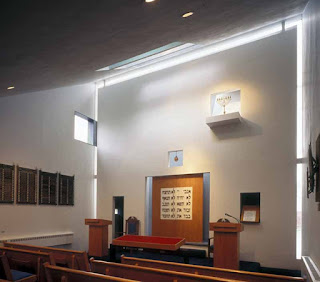The Preservation
Association of Central New York (PACNY)
Invites you to an
illustrated lecture by
Prof. Bruce M. Coleman
Werner Seligmann: A Modern
Architect in Upstate New York
Sunday, May 20. 2012
2:00 pm
Barnes Mansion
930 James Street, Syracuse
PACNY members $10,
all others $15.
Werner Seligmann
Werner Seligmann (1930-1998) is arguably Central
New York’s best known modern architect. As a practicing architect, influential
teacher and a Dean of Syracuse University’s School
of Architecture, he put his stamp on New York State design,
and shaped the architectural aesthetic of several generations of architectural
students and professionals.
Born in Osnabrück,
Germany, Seligmann spent the latter part of World War II in a concentration camp; unfortunately his
mother and sister did not survive the camps. After the war he was sent to the US to live with relatives in Groton
New York, beginning his long association with Central New York.
Seligmann received his Bachelor's in Architecture
degree from Cornell in 1955. He was licensed in 1956 and taught as an
Instructor at the University of Texas at
Austin from 1956-58, where he became part of a small group of faculty
that
would later be nicknamed The Texas Rangers; a group that included Colin
Rowe, John Shaw, Robert Slutzky and John Hejduk. After the group was
dismissed
from Austin, Seligmann pursued graduate study in
Braunschwieg, Germany, then taught at the
Eidgenossiche Technische Hochscule (the ETH), in Zurich, Switzerland
from 1959-61. He returned to New York State
to teach at Cornell from 1961 to 1974, then spent two years as Associate
Professor of Architecture at Harvard, before becoming Dean and Professor of
Architecture at Syracuse
University, where he
served from 1976-90. Seligmann was subsequently named Distinguished Professor of
Architecture at Syracuse
University, a position he
held until his death.
Throughout his teaching career
Seligmann maintained a practice and entered many competitions. His firm, Werner
Seligmann and Associates, Architects and Urban Designers, was launched in 1961,
and was based primarily in Cortland,
New York. Seligmann won two Progressive
Architecture Design Awards, was illustrated on the cover of PA three times, and
has placed or won several national and international design competitions. His
work on developing housing prototypes for the New York State Urban Development
Corporation in the 1970’s and 1980’s established his reputation in the area of
housing. His buildings are meticulously detailed, technically researched and
spatially inventive. His synagogues in Binghamton and Cortland
are widely regarded as important contributions to modern religious
architecture.
 |
| Cortland, NY. Synagogue. View into sanctuary. Werner Seligmann, architect. Photo: Paul Rocheleau Click here to read more about this synagogue. |
Bruce Coleman is Professor of Architecture at Syracuse University where he has taught since
1976. In private practice, Coleman worked with Joseph Cerutti & Associates
in Cleveland and then worked ten years as an
architect with Werner Seligmann & associates in Cortland, New York. Coleman’s teaching focuses on
computer-aided design (CAD) and he was instrumental in setting up the shared IBM CAD
lab at Syracuse
University. In his private practice he has focused on
residential and religious work. Coleman
is completing a monograph about the work of Werner Seligmann. This lecture presents some of the projects
described in the monograph as well as analysis and conclusions about Seligmann’s influence – during his
life, and today.






.JPG)






No comments:
Post a Comment